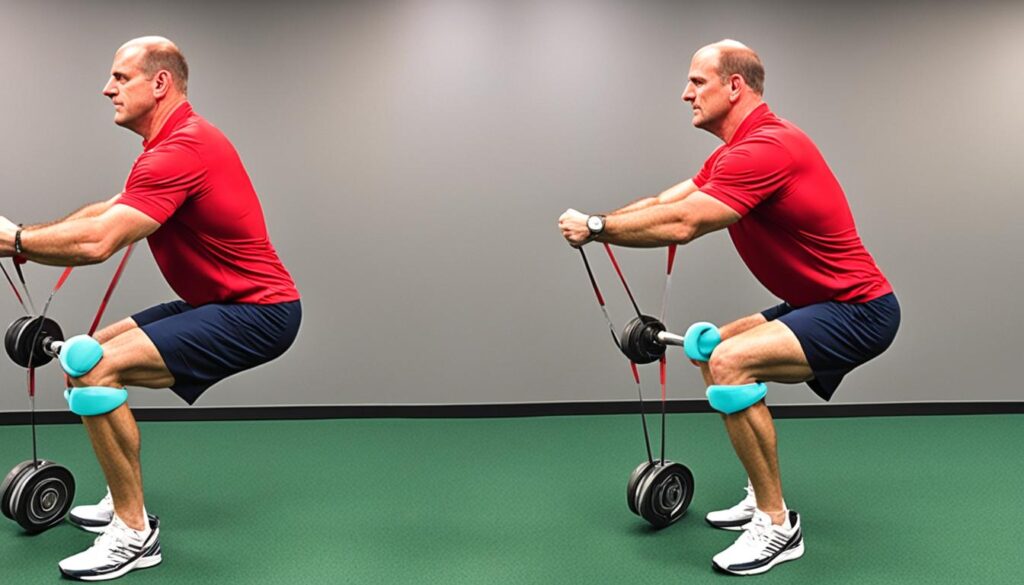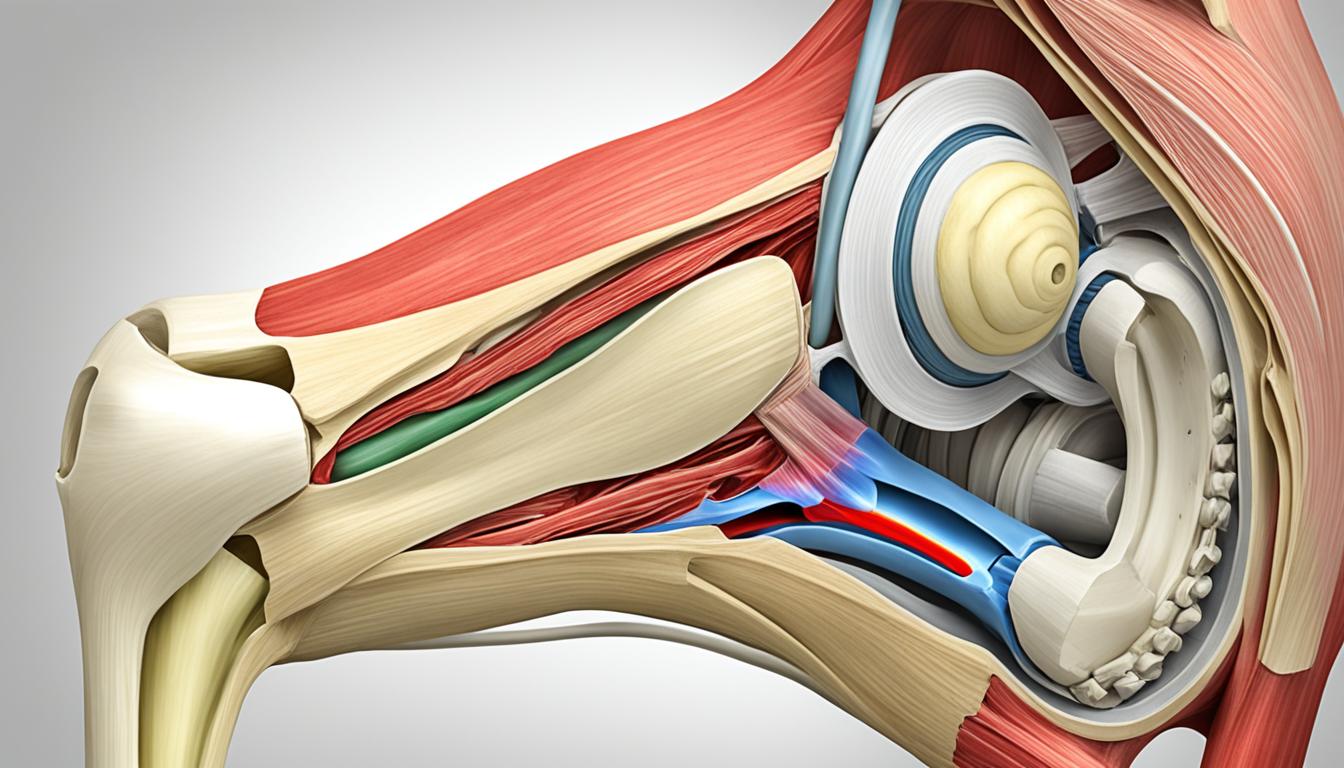Importance of the Patella in Knee Function
Did you know that the patella, also known as the kneecap, is the largest sesamoid bone in the body? Its size alone speaks to the crucial role it plays in knee function. Located within the quadriceps tendon, anterior to the knee joint, the patella serves multiple functions that are vital for maintaining knee joint stability and efficient movement.
The patella acts as an attachment point for the quadriceps tendon and the patellar ligament, increasing the effective extension capacity of the quadriceps muscle. It also protects the quadriceps tendon from frictional forces and acts as a bony shield for deeper structures in the knee joint. Without a properly functioning patella, knee stability is compromised, and movement becomes inefficient.
Understanding the importance of the patella and its role in knee function is essential for maintaining knee joint stability and preventing knee pain. In this article, we will explore the biomechanics of the patella, common conditions that affect it, evaluation methods for patellar health, treatment options, and the overall significance of the patella in knee joint stability. Let’s dive deeper into the fascinating world of the patella and its impact on our knee health.
Importance of Patellar Biomechanics in Knee Function
Patellar biomechanics play a significant role in maintaining proper knee function and promoting overall knee health. The function of the patella goes beyond just being a bony structure in the knee joint. It acts as a crucial fulcrum, enhancing the efficiency of knee extension and reducing the force required for full extension.

When the knee is extended, the patella increases the moment arm, resulting in a greater lever arm for the quadriceps muscle to generate torque on the tibia. This mechanism allows for smoother and more effortless movement during knee extension, preventing excessive strain on the joint.
In addition to its role in knee extension, the patella also plays a crucial part in patellar tracking within the patellofemoral joint. Proper patellar tracking ensures smooth movement of the knee during flexion and extension, reducing the risk of patellofemoral joint dysfunction and associated knee pain.
Correct patellar biomechanics are essential for preventing knee pain and maintaining optimal patellofemoral joint health. When the patella is functioning optimally, the joint experiences minimal wear and tear, reducing the risk of degenerative conditions and enhancing long-term joint health.
Benefits of Proper Patellar Biomechanics:
- Efficient knee extension with reduced force requirements
- Improved patellar tracking for smooth knee movement
- Prevention of patellofemoral joint dysfunction
- Reduced risk of knee pain and discomfort
- Enhanced patellofemoral joint health and longevity
Understanding the importance of patellar biomechanics highlights its integral role in knee function and the prevention of knee pain. By prioritizing proper patellar tracking and biomechanics, we can take proactive steps to maintain patellofemoral joint health and prevent potential knee problems in the future.
Common Conditions and Disorders that Affect the Patella
The patella, also known as the kneecap, is susceptible to various conditions and disorders that can cause knee pain and affect its function. Understanding these common issues can help individuals recognize the symptoms and seek appropriate medical attention for early intervention and treatment.
1. Patellar Dislocation
One common condition that affects the patella is patellar dislocation. This occurs when the patella completely moves out of its normal position within the patellofemoral groove. Patellar dislocation can result from traumatic injuries, such as falls or direct blows to the knee, or from underlying joint instability.
When the patella dislocates, individuals may experience severe pain, swelling, and an inability to straighten the knee. Prompt medical attention is necessary to relocate the patella and prevent further damage. In some cases, surgical intervention may be required to stabilize the patella and prevent future dislocations.
2. Patellar Subluxation
Another condition that affects the patella is patellar subluxation. This occurs when the patella partially moves out of its normal position but returns to its original place on its own. Patellar subluxation can also be caused by traumatic injuries or joint instability.
Individuals experiencing patellar subluxation may feel a sensation of the patella “slipping” or “giving way” during physical activity. While the patella returns to its normal position, it can lead to pain, instability, and difficulty with knee movements. Treatment options for patellar subluxation may include physical therapy exercises to strengthen the muscles around the knee joint and reduce the risk of further subluxations.
3. Osteoporosis and Patellar Fractures
Osteoporosis is a condition characterized by weakened bones, making them more prone to fractures. While osteoporosis commonly affects the spine and hips, it can also impact the patella and increase the risk of fractures in this area.
Fractures of the patella can cause severe pain, swelling, and limited mobility. Treatment options for patellar fractures depend on the severity of the fracture but may include immobilization with a brace, physical therapy, or surgical repair.
It is important to seek medical attention if experiencing knee pain or symptoms of patellar instability. Early diagnosis and proper management can help prevent complications and promote optimal knee health.

| Condition | Symptoms | Treatment |
|---|---|---|
| Patellar Dislocation | Pain, swelling, inability to straighten the knee | Relocation, immobilization, physical therapy, possible surgery |
| Patellar Subluxation | Sensation of patella “slipping,” pain, instability | Physical therapy, exercises to strengthen muscles around the knee joint |
| Osteoporosis and Patellar Fractures | Pain, swelling, limited mobility | Brace immobilization, physical therapy, surgical repair if necessary |
Tests and Imaging for Evaluating Patellar Health
To evaluate the health of the patella, various tests and imaging techniques are used. These tests help determine the appropriate treatment plan for patellar conditions and disorders.
One of the most common tests used to assess patellar health is the patella reflex test. In this test, the knee is tapped below the patella to elicit an involuntary reflex. The presence and strength of the reflex can provide insight into the functioning of the patella and its associated nerves.
In addition to the patella reflex test, imaging tests are frequently employed to further evaluate patellar health. X-rays are a commonly used imaging technique to assess for patellar injuries, fractures, or the presence of osteoporosis. X-rays can provide detailed images of the patella and surrounding structures, helping healthcare professionals make accurate diagnoses and develop appropriate treatment plans. Other imaging tests, such as MRIs or CT scans, may be utilized in more complex cases or when further evaluation is needed.
These tests and imaging techniques play a crucial role in understanding the extent of patellar conditions and disorders. By providing detailed insights into the health and structural integrity of the patella, healthcare professionals can make informed decisions regarding treatment options, including conservative approaches or surgical interventions.
Treatments for Patellar Conditions and Disorders
Treatment options for patellar conditions and disorders vary depending on the specific condition and its severity. In many cases, conservative treatments may be sufficient, such as wearing a brace or immobilizing device, resting, and engaging in physical therapy exercises to strengthen the surrounding muscles.
**At-home treatments** like **icing** and **over-the-counter pain relievers** can also provide relief for patellar conditions. Icing the affected area helps reduce inflammation and relieve pain. Over-the-counter pain relievers, such as nonsteroidal anti-inflammatory drugs (NSAIDs), can help manage pain and inflammation as well.
Proper rest and avoiding activities that worsen the condition are crucial for the recovery process. It is important to listen to your body and give it the time it needs to heal.
In cases of **patellar fractures** or **osteoporosis**, more intensive treatment approaches may be necessary. **Fracture treatment** typically involves immobilization with a cast or a brace to allow the bone to heal properly. In severe cases, surgery may be required to realign the fragments and stabilize the patella.
**Osteoporosis treatment** focuses on strengthening the bones and preventing further bone loss. This may involve a combination of medications, lifestyle changes, and nutritional adjustments to promote bone density and overall bone health.
Each patellar condition is unique, and the treatment plan should be tailored to individual needs. It is important to consult with a healthcare professional to determine the most appropriate treatment options for your specific situation.
Treatment Options for Patellar Conditions and Disorders
| Treatment | Description |
|---|---|
| Braces or immobilizing devices | Wearing a brace or immobilizing device to provide support and stability to the patella and surrounding structures. |
| Rest | Taking a break from activities that aggravate the patellar condition to allow for healing and recovery. |
| Physical therapy exercises | Engaging in prescribed exercises to strengthen the surrounding muscles and improve joint stability. |
| At-home treatments | Utilizing techniques such as icing and over-the-counter pain relievers to reduce inflammation and manage pain. |
| Fracture treatment | Immobilizing the patella with a cast or a brace to promote proper healing. Surgery may be required for severe fractures. |
| Osteoporosis treatment | Focusing on strengthening the bones and preventing further bone loss through medication, lifestyle changes, and nutritional adjustments. |
The Role of Patella in Knee Joint Stability and Prevention of Knee Pain
The patella, also known as the kneecap, plays a crucial role in maintaining knee joint stability and preventing knee pain. It serves as a bony shield, protecting the knee joint from external forces and distributing them evenly across the joint. This reduces the risk of injury and instability, keeping the knee joint strong and secure.
Moreover, the patella improves the efficiency of knee extension by increasing the moment arm of the knee. This allows the quadriceps muscles to generate torque on the tibia, facilitating smooth and powerful movements. By optimizing knee extension, the patella helps prevent excessive strain on the knee, minimizing the risk of pain and discomfort.
In addition to its protective and biomechanical functions, the patella also plays a key role in proper patellar tracking. It ensures that the patella glides smoothly along the trochlear groove of the femur during knee flexion and extension. This reduces friction and wear on the joint surfaces, promoting joint health and longevity.
Understanding the importance of the patella allows individuals to take proactive steps in maintaining knee health and preventing pain. By adopting habits that support knee joint stability, such as engaging in regular exercise to strengthen the surrounding muscles and avoiding activities that put excessive stress on the knee, one can significantly reduce the risk of knee pain and injury.
Proper care and attention to the patella, along with overall knee joint health, can lead to a pain-free and active lifestyle. So, let’s prioritize the well-being of our patella and ensure the stability and longevity of our knee joints.
Conclusion
In conclusion, the patella plays a vital role in knee function and joint stability. Its proper biomechanics and tracking are essential for efficient movement and the prevention of knee pain. By understanding the importance of the patella, we can better care for our knee health and seek appropriate treatment when needed. By prioritizing the health of our patella, we can maintain a healthy and functional knee joint, leading to an improved quality of life.
Whether it’s engaging in regular exercise, wearing proper protective gear during physical activities, or seeking medical attention for any symptoms or conditions related to the patella, taking care of our knee health should always be a priority. The patella’s role in knee joint stability cannot be overstated, and by maintaining its proper function, we can minimize the risk of injury and maximize our mobility.
Remember, a healthy patella means a healthier knee joint overall. By incorporating simple preventive measures into our daily lives and staying proactive about our knee health, we can ensure that the patella continues to fulfill its important role in supporting our knee function and maintaining joint stability. Let’s prioritize our patella and enjoy a life of pain-free movement.
FAQ
Why is the patella important in knee function?
The patella plays a crucial role in knee function by acting as an attachment point for the quadriceps tendon and the patellar ligament. It also increases the effective extension capacity of the quadriceps muscle, protects the quadriceps tendon from frictional forces, and acts as a bony shield for deeper structures in the knee joint.
What is the function of the patella?
The patella increases the moment arm of the knee during extension, allowing the quadriceps to generate torque on the tibia. This improves the efficiency of knee extension and reduces the amount of force required for full extension. The patella also contributes to the proper tracking of the patellofemoral joint, ensuring smooth movement of the knee during flexion and extension.
How does the patella contribute to knee joint stability?
The patella acts as a bony shield and helps distribute forces evenly across the knee joint. It improves the stability of the knee by reducing the risk of injury and instability. Its proper tracking and biomechanics also prevent excessive friction and wear on the joint surfaces.
What are some common conditions and disorders that affect the patella?
Common conditions that affect the patella include patellar dislocation, patellar subluxation, and osteoporosis. Patellar dislocation and subluxation can occur due to injuries or joint instability, while osteoporosis weakens the bones, including the patella, and increases the risk of fractures.
How is the health of the patella evaluated?
The health of the patella can be evaluated through various tests and imaging techniques. The most common test is the patella reflex test, where the knee is tapped below the patella to elicit an involuntary reflex. Imaging tests, such as X-rays, may be performed to assess patellar injuries, fractures, or the presence of osteoporosis.
What are the treatment options for patellar conditions and disorders?
The treatment options for patellar conditions and disorders depend on the specific condition and its severity. In many cases, conservative treatments such as wearing a brace or immobilizing device, resting, and engaging in physical therapy exercises to strengthen the surrounding muscles may be sufficient. At-home treatments like icing and over-the-counter pain relievers can also provide relief. However, more intensive treatment approaches, including surgery, may be necessary for patellar fractures or osteoporosis.
How does the patella contribute to the prevention of knee pain?
The patella helps distribute forces evenly across the knee joint, reducing the risk of excessive stress and strain on the surrounding structures. Its proper tracking and biomechanics ensure smooth movement of the knee, preventing excessive friction and wear on the joint surfaces. This contributes to the prevention of knee pain and the maintenance of patellofemoral joint health.






